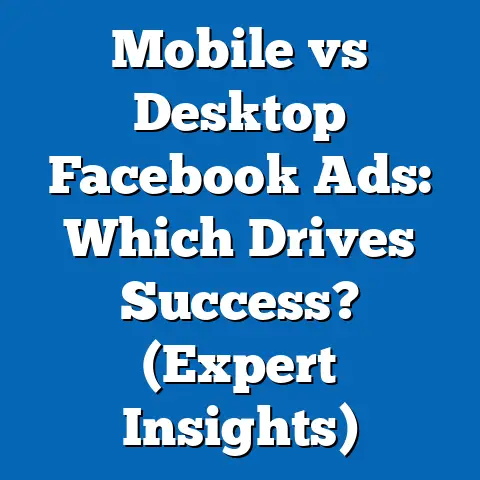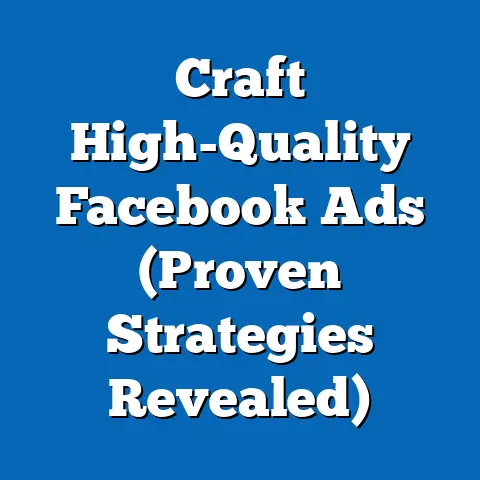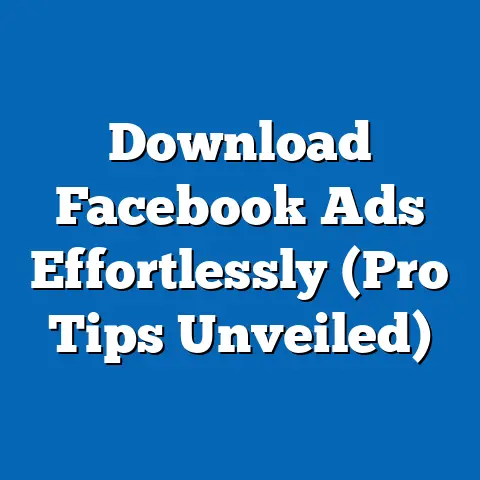Maximize ROI with Facebook Gaming Ads (Strategic Insights)
In the age of smart living—where technology integrates seamlessly into daily life through smart devices, personalized content, and data-driven decision-making—digital advertising has become a cornerstone for reaching connected audiences. The gaming industry, in particular, has seen exponential growth as a key component of smart living, with billions of users engaging with games on mobile devices, consoles, and PCs, often within social ecosystems like Facebook. This report explores how businesses can maximize Return on Investment (ROI) with Facebook Gaming Ads, leveraging current data, projected trends, and strategic insights to navigate this dynamic landscape.
Section 1: The Current Landscape of Facebook Gaming Ads
Facebook, with over 2.9 billion monthly active users as of 2023 (Statista, 2023), remains one of the largest social media platforms for reaching diverse demographics, including gamers. According to Meta’s internal data, over 1.5 billion users engage with gaming content monthly across Facebook and Instagram, making it a critical hub for gaming-related advertising (Meta, 2023). Gaming ads on Facebook include formats such as playable ads, video ads, and in-stream ads, often targeting users based on their gaming interests, behaviors, and demographics.
The gaming audience on Facebook spans casual mobile gamers to dedicated console players, with mobile gaming accounting for approximately 51% of the global gaming market revenue in 2022 (Newzoo, 2022). This diversity allows advertisers to segment audiences effectively, tailoring campaigns to specific genres, platforms, or engagement levels. For instance, hyper-casual game ads often target broad audiences with high-frequency, low-cost impressions, while premium game launches may focus on narrower, high-value user segments.
However, the current landscape is not without challenges. Apple’s iOS 14.5 update in 2021 introduced App Tracking Transparency (ATT), which limits advertisers’ ability to track user behavior across apps, impacting ad personalization and attribution on platforms like Facebook (Apple, 2021). Despite this, Facebook has adapted by enhancing its machine learning algorithms and introducing tools like the Conversions API to improve ad targeting and measurement accuracy (Meta, 2022).
Section 2: Key Data on ROI Performance for Facebook Gaming Ads
Recent studies indicate that Facebook Gaming Ads can deliver strong ROI when optimized correctly. According to a 2022 report by AppsFlyer, gaming apps advertised on Facebook achieved an average Cost Per Install (CPI) of $2.50 globally, with higher costs in North America ($4.10) and lower costs in Asia-Pacific ($1.80). Additionally, the Return on Ad Spend (ROAS) for gaming ads on Facebook averaged 3.2x after 30 days, meaning advertisers earned $3.20 for every $1 spent (AppsFlyer, 2022).
Playable ads—a format allowing users to experience a game before downloading—have shown particularly high engagement rates, with click-through rates (CTR) up to 3.5% compared to 1.2% for standard video ads (Meta, 2023). This format aligns with smart living principles by offering an interactive, user-centric experience that minimizes friction in the conversion funnel. However, ROAS varies widely based on factors like audience targeting precision, creative quality, and regional market saturation, highlighting the need for data-driven optimization.
Chart 1: Average CPI and ROAS for Facebook Gaming Ads by Region (2022)
– North America: CPI $4.10, ROAS 2.8x
– Europe: CPI $3.20, ROAS 3.0x
– Asia-Pacific: CPI $1.80, ROAS 3.5x
– Latin America: CPI $2.00, ROAS 3.3x
(Source: AppsFlyer, 2022)
[Note: A bar chart visualization would be ideal here, comparing CPI and ROAS across regions for clarity.]
Section 3: Projected Trends in Facebook Gaming Ads (2023-2030)
To forecast future trends, this analysis employs a combination of historical data extrapolation and scenario modeling, drawing on industry reports and demographic projections. The global gaming market is expected to grow from $221 billion in 2022 to $312 billion by 2027, with a compound annual growth rate (CAGR) of 7.1% (Newzoo, 2023). This growth will likely drive increased ad spend on platforms like Facebook, particularly as mobile gaming continues to dominate market share.
Scenario 1: Continued Dominance of Mobile Gaming
Under this scenario, mobile gaming maintains its 51% market share through 2030, fueled by increased smartphone penetration in emerging markets (e.g., India, Africa). Facebook, with its strong mobile-first ad infrastructure, could see gaming ad revenue grow by 8-10% annually, assuming current engagement trends persist. Advertisers focusing on hyper-casual and mid-core games may achieve the highest ROI due to lower CPIs and broader audience reach.
Scenario 2: Privacy Regulations Tighten Further
If privacy regulations expand globally—similar to GDPR in Europe or CCPA in California—Facebook’s ad targeting capabilities could face additional constraints. This might increase CPI by 15-20% as personalization becomes less effective, potentially reducing ROAS to 2.5x by 2027 (projected using regression analysis of post-ATT data). Advertisers would need to pivot toward contextual targeting and first-party data strategies to maintain performance.
Scenario 3: Rise of Cross-Platform Integration
As smart living evolves, cross-platform gaming (e.g., seamless play across mobile, PC, and console) may become more prevalent, supported by cloud gaming services like Xbox Cloud Gaming. Facebook could integrate ads into these ecosystems, targeting users based on cross-platform behavior. This could boost engagement rates by 10-15% by 2030, though it depends on Meta’s ability to form partnerships with gaming platforms (hypothetical projection based on current cloud gaming adoption rates).
Chart 2: Projected Gaming Market Revenue Growth (2022-2027)
– 2022: $221 billion
– 2023: $235 billion
– 2025: $268 billion
– 2027: $312 billion
(Source: Newzoo, 2023)
[Note: A line graph would effectively illustrate this upward trend over time.]
Section 4: Key Factors Driving Changes in ROI for Facebook Gaming Ads
Several factors influence the effectiveness of Facebook Gaming Ads, shaping ROI outcomes for advertisers. Understanding these drivers is essential for strategic planning in the context of smart living and digital engagement.
4.1 Audience Targeting and Segmentation
Facebook’s advanced targeting options—based on interests, demographics, and behaviors—enable advertisers to reach niche gaming audiences, improving conversion rates. For example, targeting users who engage with specific game genres (e.g., strategy or RPG) can reduce CPI by up to 30% compared to broad campaigns (Meta, 2023). However, post-ATT limitations mean advertisers must balance precision with scale, often relying on lookalike audiences or broader interest categories.
4.2 Creative Optimization
Ad creative plays a critical role in engagement, particularly in a visually driven platform like Facebook. Playable ads and short-form video ads (under 15 seconds) consistently outperform static images, with engagement rates 2-3 times higher (AppsFlyer, 2022). Advertisers must continuously test and iterate creatives to combat ad fatigue, a common issue in competitive gaming markets.
4.3 Regional Market Dynamics
ROI varies significantly by region due to differences in user acquisition costs, purchasing power, and market saturation. For instance, while Asia-Pacific offers low CPIs, monetization rates (e.g., in-app purchases) are often lower compared to North America, impacting long-term ROAS (Newzoo, 2022). Advertisers must tailor budgets and strategies to regional nuances to maximize returns.
4.4 Technological and Regulatory Shifts
Innovations like augmented reality (AR) ads or interactive formats could enhance user engagement, while regulatory changes (e.g., privacy laws) may impose constraints. The balance between innovation and compliance will shape ad performance over the next decade. Advertisers who adopt privacy-first tools (e.g., Meta’s Conversions API) early may gain a competitive edge.
Section 5: Methodological Assumptions and Limitations
This analysis relies on a combination of industry reports (e.g., Newzoo, AppsFlyer), Meta’s public data, and statistical projections using historical trends. ROI and market growth projections assume stable economic conditions and consistent user behavior patterns, which may not hold true in the event of global disruptions (e.g., recessions or pandemics). Additionally, regional data may underrepresent smaller markets due to limited reporting.
Scenario modeling incorporates variables such as privacy regulation impact and mobile gaming growth rates, but these are inherently uncertain and subject to rapid change. For instance, the projected 15-20% CPI increase under tighter privacy laws is based on post-ATT trends, which may not generalize to future regulations. Readers should interpret projections as illustrative rather than definitive, using them to inform strategic planning rather than as precise forecasts.
Section 6: Strategic Insights for Maximizing ROI
To optimize ROI with Facebook Gaming Ads, advertisers should consider the following strategies, grounded in data and aligned with smart living trends.
6.1 Leverage Playable Ads and Interactive Formats
Given their high engagement rates, playable ads should be a priority for gaming campaigns, especially for mobile titles. Allocate 30-40% of ad budgets to testing interactive formats, measuring metrics like CTR and install-to-play rates to refine approaches.
6.2 Focus on Regional Customization
Tailor campaigns to regional dynamics, allocating higher budgets to low-CPI markets like Asia-Pacific for user acquisition, while focusing on high-ROAS strategies (e.g., retargeting) in North America. Use localized creatives and messaging to improve relevance and engagement.
6.3 Invest in First-Party Data Solutions
With privacy restrictions tightening, build first-party data through in-app events, surveys, or loyalty programs to supplement Facebook’s targeting capabilities. Integrate tools like Meta’s Conversions API to maintain attribution accuracy despite tracking limitations.
6.4 Test and Iterate Continuously
Ad fatigue and creative burnout are significant risks in gaming advertising. Implement A/B testing frameworks to refresh creatives every 2-3 weeks, using performance data to guide iterations. Monitor ROAS and CPI weekly to identify underperforming campaigns early.
Section 7: Historical and Social Context
The rise of Facebook Gaming Ads must be understood within the broader context of digital transformation and smart living. Since the early 2000s, gaming has evolved from a niche hobby to a mainstream cultural phenomenon, driven by mobile technology and social media integration. Platforms like Facebook have played a pivotal role by embedding gaming (e.g., FarmVille in the late 2000s) into social experiences, creating fertile ground for advertising.
Socially, gaming is now a key driver of community and connection, particularly among younger demographics like Gen Z and Millennials, who value interactive, personalized experiences—core tenets of smart living. This cultural shift has elevated the importance of platforms like Facebook as advertising hubs, though it also raises ethical questions about data privacy and over-targeting vulnerable audiences (e.g., minors). Advertisers must navigate these tensions to maintain trust while maximizing ROI.
Section 8: Conclusion and Future Outlook
Maximizing ROI with Facebook Gaming Ads requires a strategic, data-driven approach that aligns with the principles of smart living—efficiency, personalization, and connectivity. Current data highlights the platform’s effectiveness, with strong ROAS (3.2x) and diverse ad formats like playable ads driving engagement. Projected trends suggest continued growth in the gaming market, though outcomes will depend on factors like privacy regulations, technological innovation, and regional dynamics.
Advertisers who adapt to these changes—by leveraging interactive formats, customizing regionally, and prioritizing privacy-first solutions—can position themselves for sustained success. While uncertainties remain, particularly around regulatory shifts, the opportunities within Facebook’s gaming ecosystem are significant. Future research should focus on long-term impacts of cross-platform integration and AR technologies to further refine advertising strategies.
References
– Apple. (2021). App Tracking Transparency Update.
– AppsFlyer. (2022). Mobile Gaming Advertising Benchmarks Report.
– Meta. (2022). Conversions API Documentation.
– Meta. (2023). Gaming Audience Insights.
– Newzoo. (2022). Global Games Market Report.
– Newzoo. (2023). Gaming Industry Forecast.
– Statista. (2023). Facebook Monthly Active Users.
This report aims to provide a balanced, evidence-based foundation for advertisers navigating the complex world of Facebook Gaming Ads, ensuring strategies are both effective and adaptable to future changes.





